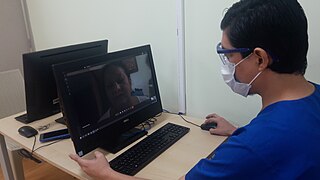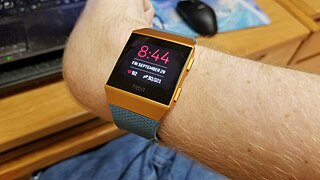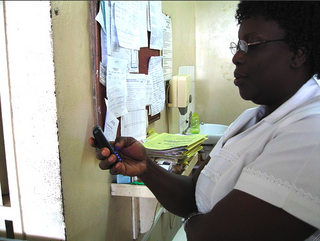
A wireless network is a computer network that uses wireless data connections between network nodes. Wireless networking allows homes, telecommunications networks and business installations to avoid the costly process of introducing cables into a building, or as a connection between various equipment locations. Admin telecommunications networks are generally implemented and administered using radio communication. This implementation takes place at the physical level (layer) of the OSI model network structure.

Telemetry is the in situ collection of measurements or other data at remote points and their automatic transmission to receiving equipment (telecommunication) for monitoring. The word is derived from the Greek roots tele, 'remote', and metron, 'measure'. Systems that need external instructions and data to operate require the counterpart of telemetry: telecommand.

Wireless communication is the transfer of information (telecommunication) between two or more points without the use of an electrical conductor, optical fiber or other continuous guided medium for the transfer. The most common wireless technologies use radio waves. With radio waves, intended distances can be short, such as a few meters for Bluetooth or as far as millions of kilometers for deep-space radio communications. It encompasses various types of fixed, mobile, and portable applications, including two-way radios, cellular telephones, personal digital assistants (PDAs), and wireless networking. Other examples of applications of radio wireless technology include GPS units, garage door openers, wireless computer mouse, keyboards and headsets, headphones, radio receivers, satellite television, broadcast television and cordless telephones. Somewhat less common methods of achieving wireless communications involve other electromagnetic phenomena, such as light and magnetic or electric fields, or the use of sound.

Palpitations are perceived abnormalities of the heartbeat characterized by awareness of cardiac muscle contractions in the chest, which is further characterized by the hard, fast and/or irregular beatings of the heart.

In medicine, a Holter monitor is a type of ambulatory electrocardiography device, a portable device for cardiac monitoring for at least 24 hours.
Wireless sensor networks (WSNs) refer to networks of spatially dispersed and dedicated sensors that monitor and record the physical conditions of the environment and forward the collected data to a central location. WSNs can measure environmental conditions such as temperature, sound, pollution levels, humidity and wind.

Telehealth is the distribution of health-related services and information via electronic information and telecommunication technologies. It allows long-distance patient and clinician contact, care, advice, reminders, education, intervention, monitoring, and remote admissions. Telemedicine is sometimes used as a synonym, or is used in a more limited sense to describe remote clinical services, such as diagnosis and monitoring. When rural settings, lack of transport, a lack of mobility, conditions due to outbreaks, epidemics or pandemics, decreased funding, or a lack of staff restrict access to care, telehealth may bridge the gap as well as provide distance-learning; meetings, supervision, and presentations between practitioners; online information and health data management and healthcare system integration. Telehealth could include two clinicians discussing a case over video conference; a robotic surgery occurring through remote access; physical therapy done via digital monitoring instruments, live feed and application combinations; tests being forwarded between facilities for interpretation by a higher specialist; home monitoring through continuous sending of patient health data; client to practitioner online conference; or even videophone interpretation during a consult.

A heart rate monitor (HRM) is a personal monitoring device that allows one to measure/display heart rate in real time or record the heart rate for later study. It is largely used to gather heart rate data while performing various types of physical exercise. Measuring electrical heart information is referred to as electrocardiography.
eHealth describes healthcare services which are supported by digital processes, communication or technology such as electronic prescribing, Telehealth, or Electronic Health Records (EHRs). The use of electronic processes in healthcare dated back to at least the 1990s. Usage of the term varies as it covers not just "Internet medicine" as it was conceived during that time, but also "virtually everything related to computers and medicine". A study in 2005 found 51 unique definitions. Some argue that it is interchangeable with health informatics with a broad definition covering electronic/digital processes in health while others use it in the narrower sense of healthcare practice using the Internet. It can also include health applications and links on mobile phones, referred to as mHealth or m-Health.
Lively is a connected health technology company based in the United States of America.

Cardiac monitoring generally refers to continuous or intermittent monitoring of heart activity to assess a patient's condition relative to their cardiac rhythm. Cardiac monitoring is usually carried out using electrocardiography, which is a noninvasive process that records the heart's electrical activity and displays it in an electrocardiogram. It is different from hemodynamic monitoring, which monitors the pressure and flow of blood within the cardiovascular system. The two may be performed simultaneously on critical heart patients. Cardiac monitoring for ambulatory patients is known as ambulatory electrocardiography and uses a small, wearable device, such as a Holter monitor, wireless ambulatory ECG, or an implantable loop recorder. Data from a cardiac monitor can be transmitted to a distant monitoring station in a process known as telemetry or biotelemetry.

mHealth is an abbreviation for mobile health, a term used for the practice of medicine and public health supported by mobile devices. The term is most commonly used in reference to using mobile communication devices, such as mobile phones, tablet computers and personal digital assistants (PDAs), and wearable devices such as smart watches, for health services, information, and data collection. The mHealth field has emerged as a sub-segment of eHealth, the use of information and communication technology (ICT), such as computers, mobile phones, communications satellite, patient monitors, etc., for health services and information. mHealth applications include the use of mobile devices in collecting community and clinical health data, delivery/sharing of healthcare information for practitioners, researchers and patients, real-time monitoring of patient vital signs, the direct provision of care as well as training and collaboration of health workers.
The Zambia Electronic Perinatal Record System (ZEPRS) is an Electronic Medical Record (EMR) system used by public obstetric clinics and a hospital in Lusaka, Zambia.

In medicine, monitoring is the observation of a disease, condition or one or several medical parameters over time.

Remote patient monitoring (RPM) is a technology to enable monitoring of patients outside of conventional clinical settings, such as in the home or in a remote area, which may increase access to care and decrease healthcare delivery costs. RPM involves the constant remote care of patients by their physicians, often to track physical symptoms, chronic conditions, or post-hospitalization rehab.

A body area network (BAN), also referred to as a wireless body area network (WBAN) or a body sensor network (BSN) or a medical body area network (MBAN), is a wireless network of wearable computing devices. BAN devices may be embedded inside the body as implants or pills, may be surface-mounted on the body in a fixed position, or may be accompanied devices which humans can carry in different positions, such as in clothes pockets, by hand, or in various bags. While there is a trend toward the miniaturization of devices, in particular body area networks which consist of several miniaturized body sensor units (BSUs) together with a single body central unit (BCU), larger decimeter sized smart devices still play an important role in terms of acting as a data hub or data gateway and providing a user interface to view and manage BAN applications, in-situ. The development of WBAN technology started around 1995 around the idea of using wireless personal area network (WPAN) technologies to implement communications on, near, and around the human body. About six years later, the term "BAN" came to refer to systems where communication is entirely within, on, and in the immediate proximity of a human body. A WBAN system can use WPAN wireless technologies as gateways to reach longer ranges. Through gateway devices, it is possible to connect the wearable devices on the human body to the internet. This way, medical professionals can access patient data online using the internet independent of the patient location.

A medical tricorder is a handheld portable scanning device to be used by consumers to self-diagnose medical conditions within seconds and take basic vital measurements. While the device is not yet on the mass market, there are numerous reports of other scientists and inventors also working to create such a device as well as improve it. A common view is that it will be a general-purpose tool similar in functionality to a Swiss Army Knife to take health measurements such as blood pressure and temperature, and blood flow in a noninvasive way. It would diagnose a person's state of health after analyzing the data, either as a standalone device or as a connection to medical databases via an Internet connection.
Preventice, Inc., formerly known as Boost Information Systems, Inc., was founded in 2007 by Jonathan Otterstatter, Scott Burrichter, Greg Wobig, and Dan Spors. The company is headquartered in Rochester, Minnesota.
Wireless ambulatory electrocardiography (ECG) is a type of ambulatory electrocardiography with recording devices that use wireless technology, such as Bluetooth and smartphones, for at-home cardiac monitoring (monitoring of heart rhythms). These devices are generally recommended to people who have been previously diagnosed with arrhythmias and want to have them monitored, or for those who have suspected arrhythmias and need to be monitored over an extended period of time in order to be diagnosed.
AliveCor is a medical device and AI company that develops ECG hardware and software compatible with consumer mobile devices to enable remote heart rhythm monitoring and detection of abnormal heart rhythms, or arrhythmias. AliveCor was founded in 2011 and is headquartered in Mountain View, California, the United States.












